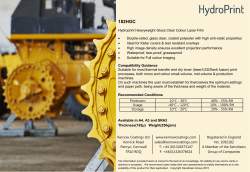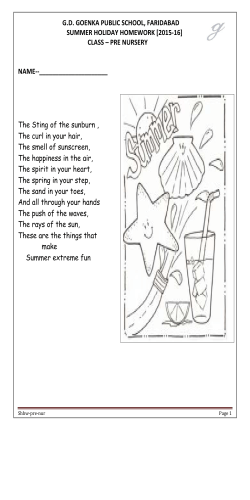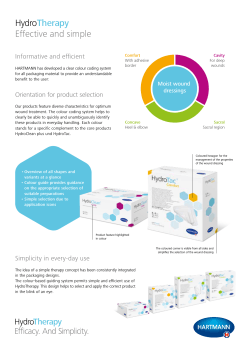
Crombie Wee Wellie Wander Facilitators Pack
Wee Wellie Wander Facilitators Pack Early Years Outdoor activities are a great way to explore, engage and have fun in your natural environment. This pack aims to highlight how the outdoors can provide a rich and meaningful context for learning across the curriculum by stimulating the senses to create a memorable experience and to inspire questioning, critical thinking, creativity and expression. Welcome Welcome! I hope that you enjoy using some of the creative activities in this pack. It has been great fun creating them and I hope that you and your pupils have a terrific time investigating the outdoors with them. Please use this pack creatively to suit your needs, perhaps as a starting point or to further develop learning ideas. I am always inspired by being outside and I hope that you are too! I would like to thank Astrid Leeson, the AAIS mentees and the Ranger Service at Crombie Country Park for partnering me with this work. Louise Kirby, Project Artist in Residence at EDS, Angus Council Crombie Country Park is a wonderful place for children to enjoy, explore and engage with the natural environment. An outdoor Wee Wellie Wander learning experience will be one that is remembered for all the right reasons! Learning outdoors can be enjoyable, creative, challenging and adventurous. Crombie has a vibrant mosaic of habitats brimming with wildlife such as woodpeckers, deer and squirrels. Its dynamic woodlands change with the seasons to provide a rich resource which will energise and provoke the natural curiosity of even the oldest members of a community, regardless of the weather! It is the ideal location to interest and engage children in their learning. Suggested dialogue for children ‘We are going to Crombie Country Park to see what we can discover. We are going on an artist’s walk, where we will have to look up, down, inside, under, so that we can find lots of things to use creatively. On our journey we’re going to collect things to peg on our Memory String so that we can take it back and think and talk about what we found out and what we want to learn some more about.’ Ranger Centre & Bus Parking and toilets STARTING POINT Magic Spot Car Park and toilets Tree Time Wheelchair Accessible Path Route of the Wee Wellie Wander at Crombie Country Park Magic Spot Tree Time Woodland Weaving Woodland Story Time Land Shapes Creative Creatures Memory String (throughout) Ground Graffiti You’ve been framed Funky Specs Legwarmer Trees Bumpy Barks Stacked Leaves Nature’s Palette Ground Graffiti Mirror, Mirror Funky Specs Memory String (throughout) Leaf Trail You’ve been framed Memory String Memory String Create a visual journey of your outdoor adventure. Idea: Instructions A MemoryasString is aholding creative for children to •Working a team theway string. remember their journey/experience by pegging •You’ll find interesting spots where you see, hear on reminders. Photos can be added later and or smell something. You to may find information leaves, pineand the Memory String used recall cones, old crisp bag, helicopter seeds…..Stop at discoveries. appropriate places, ask the pupils what could Working team, hold the string and they addas to athe stringchildren to remember this place. stop appropriate spots where (Keepatthe string taught to peg on interesting the reminder.) smells, sounds and sights have been detected. •Photograph the area for future reference. This might include such items as leaves, pine •cones, Chat about the bag objects is it, what is to it old crisp and- what helicopter seeds madeonto from, where it come peg the string.did (Keep thefrom? string taut to peg •Move on the journey and discover what on the along reminder) other reminders you can find. Discuss the items - what is it?discuss what isthe it made •At the end of your journey objects from? where did it come from? and recall what you saw, heard, smelt and made. Resources: String (2 metres per group of 6) Pegs (12 per group of 6) Further Ideas: Display the Memory String as a physical map back at your setting and add photographs and artworks to it. Watch how the Memory String changes as the natural materials decay over time. Photograph the area for future reference. Move along on the journey to discover what other natural treasures exist in the outdoors. At the end of your travels, discuss and recall what you saw, heard, smelled and made. This activity can be used throughout the outdoor journey. Encourage literacy with descriptive words to describe the objects collected, e.g. rough, smooth, worn, natural, manmade, organic, stem, veins. Legwarmer Trees Legwarmer Trees Create a colourful stripy legwarmer for the tree. Idea: Creating a tree legwarmer is a fun way to get up close and personal to trees in order to learn more about them. Resources: Range of balls of wool (approx. 1 ball per pair - bright colours stand out well) Pair of scissors Work in pairs or individually to wool wrap different types of tree. Secure the coloured ball of wool wither by wrapping it round once and tying a knot or tuck the wool into the bark and start wrapping. Do this with each, separate colour. Investigate the texture and patterns of the bark… Look up to see the shape of the branches… Look down to discover any roots… Discover who might live in the bark, roots and branches while walking round the tree, wrapping the wool, nice and tight. Further Ideas: Look at the stripes with a mirror to see the them multiply. Try looking at the tree wrapping colours with your Funky Spec Look online to find examples of different forms of ‘Yarn Bombing’. Compare and contrast different tree discoveries and make further enquiries about the differences detected. Negotiate the direction of wrapping with each other. Try it clockwise and anti-clockwise just for fun! Or sing a song as you go round. Take photos of the tree and all its stripy lines as a reminder. Unwrap the tree or cut the wool and remove before you move on! Use the wool scraps back in school.. Encourage literacy, e.g. line, horizontal, thick, thin, fuzzy, wide, wiggly, delicate, stripy, pattern, textiles, bark, rough, bumpy, corrugated, scratchy, wavy. Funky Specs Funky Specs Look through the cellophane glasses to see the world quite differently. Idea: Instructions Viewing the surroundings in different •Look through the cellophane glasses colours using the Funky Specs can help to focus •What has changed? attention on things that might normally have •Look unnoticed! at the sky. gone •How has the sky changed? •Lookthrough at the leaves; does it make themand lighter or Look the cellophane glasses prompt lots of thinking/questions, e.g. darker? Look How hashappens? the sky changed? •Lookat atthe yoursky. hand what Look at the leaves. Does it make lighter or •Try the other coloured glasses andthem see what darker? happens. Look at your hand what happens? Try the other coloured glasses and see what happens. Resources Cellophane Glasses (Looking Tool) Further Ideas: Create coloured cellophane shapes and tape to a window like stained glass to see life outside the classroom in a different light. Layer up different colours of cellophane and see what happens. Create your own glasses with cellophane or recycled sweet wrappers, lay out in between laminate sheets then laminate. Encourage literacy with descriptive words to describe the colour and changes, e.g. transparent, clear, change, lighter, darker, shade, tint, glow, bright, dull, warm. Autumn Activity Stacked Leaves Stacked Leafy Sculptures Create a mini sculpture with leaves. Idea: Find a stick and place into the ground then Instructions gather fallen leaves to create Stacked Leafy •Find a stick and place into the ground. Sculptures. Sculptures •Gather fallen leaves. Lay group into into colours colours. •Layout outthe theleaves leaves and and group •Stack the leaves by gently piercing through the Stack the leaves gently between piercing through twig. (Varying theby distance leaves.) the twig varying the distance between them. Make •Photograph your leafy sculpture. aware of any risk of hurting self. •What will happen to the sculpture over time? •Make lots toyour create a group of leafy stack stacked leafy sculpture. Photograph sculpture sculptures. Make lots to create a group of stacked leafy sculptures. sculptures Discuss what will happen to the sculptures over time. Prompt an enquiry into why the leaves change colour and how this happens. Autumn Activity Resources: Found objects on location - leaves and a stick Further Ideas: Pierce coloured papers onto pencils and stand with Blu tac. Sort leaves into colour, shape and size. Take rubbings of the leaves with a thin paper and soft pencil or crayon. Take an imprint of the leaf in plasticine. Look at the work of artist Andy Goldsworthy for further ideas about creative use of natural materials. Take a print of the leaves by lightly covering with paint and printing onto paper. Place the leaves on a light box or overhead projector to see the detail in the lines on a big scale. Follow line with finger or drawing materials. Encourage literacy with descriptive words, e.g. shape, organic, natural, pierce, stacked, layer, fragile, land art, sculptural. Bumpy Bark Bumpy Bark Create your own imprint of the texture of the tree. Idea: Recording the texture and pattern of a bumpy bark for further discussion. Squish a ball of plasticine in your hands to warm up then pat flat and smooth out. Press onto interesting texture on a tree bark then peel off gently. Look closely and see the texture, lines and patterns of the bark. Take a photo as a memory jogger. Squish it up again and try another tree. Resources: Plasticine Camera Further Ideas: Try a rubbing different bark textures with thin paper and soft pencil or crayon. Photograph close ups of the tree bark texture. Create mixed media texture with a variety of materials such as scrunched up tissue, cotton wool, shavings, mixed with paint and PVA glue to replicate bark texture. Take imprints of other textures – leaves, walls, manhole cover to investigate. Compare and contrast different tree textures, inviting further enquiry questions. Ask what it feels like? Encourage literacy with descriptive words to describe the various textures, e.g. rough, smooth, soft, hard, bobbly spiky, spongy, fluffy, bumpy, scratchy, furry, prickly, crumbly, waxy, sticky. Nature’s Palette Nature ’s Palette Nature’s Find nature’s natural colour palette in your surroundings. Idea: Find an area and place the colour spots on the ground as your canvas. Resources Colour Spots (See Teachers’ Pack) Cellophane Glasses (Funky Funky Specs) Specs (Looking Tool) Arrange the spots into a giant colour palette. Find something small of that colour and bring back to the palette, only picking things that have naturally fallen. Place next to the colour palette then discuss the colour match, e.g. is the colour the same? Different? lighter? darker? brighter? duller? Further Ideas: With paint, mix light colours and dark colours to get a range of shades and tints. Sort a box of buttons to create a giant colour palette. Decide which object is the closest in colour. Take a photo as a reminder. Look at the colour through the Funky Specs and see how the colours change. Scatter objects back to the land and pick up the colour spots. Encourage literacy with descriptive words to describe the colour, e.g. dull, bright, subtle, contrasting, lighter, darker, brighter, vibrant, pale, muted. Mirror Mirror Mirror Mirror Use mirrors to see the world double and from a different perspective. Idea: Instructions •Place a mirror at the bottom of the trunk of the Place a mirror at the bottom of the trunk of the tree. tree. Can you see all the way to the top? •Can you see all the way to the top? •Place a mirror justunder underaabush bushto todiscover discover Place a mirror just branches, nests what’s inside – creatures, trunk, trunk, branches, or spiders. spiders. •Place a mirror under your chin and see if it takes Place mirror your chin and seeit ifmake it takes you toathe top under of the trees. How does you to the top of the trees. How does it make you you feel? feel? •Place a mirror beside an object or artwork to see the symmetry/mirror Place a mirror beside image. an object or artwork to see the symmetry/mirror image. As you you go on the journey in the park see if you can see other natural mirrors that have reflections – puddles, ponds and reservoirs! Resources: Mirrors (Looking Tool) Further Ideas: Place mirrors around your building and see the patterns near the walls, gates or climbing frames. Place mirrors beside your artworks and see them double into a pattern. Look for nature mirrors such as ponds, puddles, lochs and reservoirs. Can you see the sky? Can you see the symmetry? Why are the trees upside down? Create a painted artwork and while wet take a print of it to view the symmetry. Encourage literacy with descriptive words, e.g. reflection, symmetry, upside down, underneath, dark, nest, branch, bark, bushy, inside, outside. You ’ve been framed You’ve You ’ve been framed You’ve Look through the frames to make your own pictures. Idea: Instructions •Hold the frame out at arms length. Hold the frame out at arms length, look through •Look through and move around to find the best and move around to find the best picture. picture. •What shapescan can be What shapes be seen seeninside, inside, what whatcolours colours and what and whattextures? textures? •Take a photo as a reminder. Ask probing questions – Do the trees get bigger or smaller as they go off in the distance? How does the colour change? Take a photo as a reminder. Resources Frames (Looking Tool) or bring some real ones Camera Further Ideas: Use a variety of old picture frames of all different shapes and sizes and make pictures looking at different landscapes. Use a camera like a picture frame to make the perfect picture. Place a picture frame on the ground and place objects inside to create artworks. Make a postcard of your favourite picture. Fill the frames by placing on the ground and looking at the detail. Encourage literacy with descriptive words, e.g. focus, object, shape, texture, pattern, smooth, furry, edges, frame, perspective, scale, composition, oval, rectangle, square. Autumn Activity Leaf Trail Leaf Trail Create a path of leaves. Idea: Instructions •Gather fallen leaves. Gather fallen leaves then sort into categories, •Sort into categories – shape, colour, texture or e.g. shape, colour, texture or size. size. •Working togetheras asaa team, team to createwhere the trail. Working together decide the •Decide the create trail is to start. trail is to where start then the trail, making decisions about direction as a •Taking turns, laying out one at group a time on the throughout. ground. •Pupils take the direction of the trail. The trail should be constructed systematically, •Capture the trail on the camera. children taking turns to lay out one at a time on •Look at the interesting shape it has made and the ground. how the line moves. Capture the trail on the camera. Look at the interesting shape that it has made and how the line moves. Autumn Activity Resources: Bag to collect leaves Further Ideas: Try with lego, buttons or shells back at your setting. Draw pictures and shapes with objects. Take leaves back and take a print to see all the pattern and lines within the veins. Look through a magnifying glass to see the detail in the leaves. Draw round the different leaf shapes, overlap them in different positions to create a design. Make a twig frame and create a picture. Ground Graffiti Ground Graffiti Create your own patterns and images with stencils using the ground as your canvas – as well as feeding the birds! Idea: Place stencil on the ground, holding with one hand. Resources: Stencils (in Teachers’ Pack) Large tub of bird seeds, nuts or bread crumbs Camera Take a small handful of seeds and gently sprinkle over the stencil. Fill the shape so that the stencil area is full of seeds then gently lift up the stencil. Look at the artwork you have created. Repeat the process to create patterns, pictures and designs. Flip the stencil over to create symmetry. Hide quietly and see which birds visit and eat the seeds! Take photographs. Look at how the pattern changes over time… Further Ideas: Draw and cut your own stencils or use objects to get interesting silhouettes. Try the activity indoors using small objects like buttons, sand or glitter. Photograph the artworks and use in collage and mix media art activities. Fill seeds into old salt cellar and draw pictures using the salt cellar as a pencil. Make a fat ball by smearing fat and roll into birdseed and string up and watch to see what birds come to eat it. Autumn Activity Creative Creature Autumn Activity Creative Creature Create a woodland beastie from found objects. Idea: Gather natural objects then sort into categories. Resources: Natural objects gathered from the surroundings, e.g. pine cones, leaves, helicopter seeds, twigs, etc. Choose a body shape, e.g. a pine cone is ideal as its structure is good for attaching other materials to. Leaves and helicopter seeds can be good for wings. Twigs can be good for legs. To attach either poke in or find ways to tie or wrap using found materials, such as grasses. Play with combinations to create your creative creature. Take a photo of the mini creative creature sculptures. Can you name and make characters and interactions for your creative creatures? Further Ideas: Group characters and interactions together to make a story. Draw a background scene for the setting for display. Recreate with other materials in larger scale such as papier mache or using recycled materials. Make an animation. Autumn Activity Land Shapes Autumn Activity Land Shapes Create shapes with found objects using the ground as your canvas. Idea: This is an activity that can be tackled individually or in small or large groups. Resources: Pine cones or if not pine cones use leaves A stick to be used as a giant pencil Gather pine cones from the forest floor. Find a suitable space of ground as your canvas then decide upon the shape and size of the canvas. Using the stick as a giant pencil, draw the shape then define the canvas outline with pine cones. Fill the shape with pine cones, either by ordering them systematically or at random. Create another shape. Take some photos of the forest floor creations. Try with other found objects, such as leaves and twigs. Will they still be there the next time you pass? Further Ideas: Create trails and journeys with natural objects. Sequence natural objects into size or colour then take some back to add into mixed media artwork. Create pictures with the pine cones. Create with other objects, like lego, bean bags, buttons in the playground or indoors. Use hula hoops and fill with petals, cones, leaves or objects. Create a stick picture frame and create a picture with the natural objects discovered. Woodland Story Time Woodland Story time Tell a story in a magical place to create a bit of ambience and drama. Idea: Instructions Find a comfy spot in the woods then make a •Find afor comfy spot inorthe woods. space a blanket find the natural seats created by chopped logs inor the landscape in •Make a space for a blanket find natural seats the Magic Spot (see map). in the landscape. •Bring the story to life by adding noises you hear Read the story book to the children, bringing it from environment. to lifethe by adding noises that can be heard in the •You can use a prop fromadding nature noises, such ase.g. a stick or environment or children leaf andleaves, use it to add drama – dependant the rustling whistling, clapping, rustlingon bags, using story!a stick as a drumstick. A prop from the natural surroundings, e.g. a stick or leaf can be used to add drama if appropriate to the storyline. *Story Box Workshops and training courses are available through EDS, please contact HardyM@angus.gov.uk Resources: Picnic blanket Story book (not provided but suggestions in Notes Prior to Visit) Natural object suitable for a props. Further Ideas: Tell stories in other unusual places such as tents, in the garden. Retell today’s journey discussing the sights, smells, sounds and artworks created. Make a den with some old fabric to create your own special story place. Collect a prop on your journey so the children feel part of the story. Add a bit of drama by involving children in acting out bits of the story, e.g. the character is cold and shivering so the children make corresponding actions/movements. Make up your own story on the journey by picking up a leaf and asking who might this belong to? What might his/her name be? What might he/she do here? Woodland Weaving Woodland Weaving Create your own natural fabric. Idea: The Weaving Loom is in the Magic Spot (see map). Find natural colours and textures from the forest floor (long grasses, twigs) and gather together. Resources: Natural objects on the woodland floor – grasses, thin twigs, leaves. Weaving Loom (permanent one in the Magic Spot) One by one each person adds a small strip of colour or texture to the weaving loom. NB The weaving loom strings are the warp and what you add in is the weft. To weave move the object over and under the strings with your weft then push the strip down to the edge of the loom. Next person takes a turn by moving the object over and under the opposite strings. Take a photo as a reminder of your woodland fabric. See what happens to the woodland fabric over time. Come back and see the fabric has grown! Further Ideas: Make your own loom with sticks and wrap with wool or grasses. Weave ribbons, string, wool or willow or raffia on your gates back at your setting. Wee Wellie Wander This Pack was produced by Louise Kirby, Artist in Residence with Angus Council EDS Arts and Cultural Education Team, with help from artist Astrid Leeson and Angus Artists in Schools Mentees and Lisa King, Angus Council Rangers Service. Development funding was provided by Angus Council Education Service and Creative Scotland Creative Learning Networks Fund. Angus Artists in Schools Astrid Leeson www.astridleeson.wordpress.com www.louisekirby.com
© Copyright 2025









